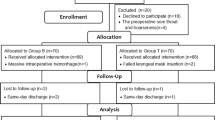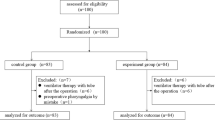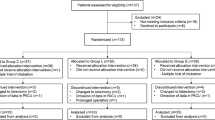Abstract
Purpose
Postoperative sore throat (POST) is a common complaint following thyroidectomy. Dexamethasone was reported to alleviate POST when administered via different routes. This study aimed to compare the effects of local spray and perineural injection surrounding the internal branch of superior laryngeal nerve (iSLN) in preventing POST and alleviating postoperative impaired voice function.
Methods
A randomized, double-blinded, controlled trial was performed to test the efficacy of the iSLN block in inhibiting of POST. A total of 161 patients who underwent elective thyroidectomy were randomly allocated to two groups. Group Spray: 4 mg dexamethasone was sprayed on to the vocal cord; Group iSLN: bilateral perineural injection with 4 mg dexamethasone around the iSLN. The incidence and severity of POST, swallowing pain, and its side effects were evaluated. Postoperative acoustic analysis, including jitter and shimmer, was also performed.
Results
Group iSLN exhibited a significantly less incidence and intensity of POST at 6 h and 24 h (P < 0.001). The patients experienced less swallowing pain at 6 h (P < 0.001) after the surgery, compared with Group Spray. When compared with Group Spray, Group iSLN improved postoperative voice function, which was characterized by lower jitter and lower shimmer value at 6 h and 24 h (P < 0.001) after the surgery. The severity of postoperative cough is higher in Group Spray (P < 0.001).
Conclusions
Among patients undergoing elective thyroidectomy, those who received perineural injection surrounding iSLN with dexamethasone had improved voice function and presented with more excellence in the inhibition of POST and cough, in comparison with the local spray.
Register information
This trial was registered in the Chinese Clinical Trial Registry on 4th Jan, 2021 (ChiCTR2100042145). The trial is registered at http://www.chictr.org.cn/showproj.aspx?proj=120142.


Similar content being viewed by others
Materials and/or code availability
The data was uploaded as a supplementary file.
References
Sumathi PA, Shenoy T, Ambareesha M, Krishna HM (2008) Controlled comparison between betamethasone gel and lidocaine jelly applied over tracheal tube to reduce postoperative sore throat, cough, and hoarseness of voice. Br J Anaesth 100(2):215–218
Lee JH, Kim SB, Lee W, Ki S, Kim M-H, Cho K et al (2017) Effects of topical dexamethasone in postoperative sore throat. Korean J Anesthesiol 70(1):58–63
Safavi M, Honarmand A, Fariborzifar A, Attari M (2014) Intravenous dexamethasone versus ketamine gargle versus intravenous dexamethasone combined with ketamine gargle for evaluation of post-operative sore throat and hoarseness: a randomized, placebo-controlled, double blind clinical trial. Adv Biomed Res 3:212
Xu YJ, Wang SL, Ren Y, Zhu Y, Tan ZM (2012) A smaller endotracheal tube combined with intravenous lidocaine decreases post-operative sore throat—a randomized controlled trial. Acta Anaesthesiol Scand 56(10):1314–1320
Myles PS, Hunt JO, Moloney JT (1997) Postoperative minor complications. Comparison between men and women. Anaesthesia 52(4):300–306
Inoue S, Abe R, Tanaka Y, Kawaguchi M (2015) Tracheal intubation by trainees does not alter the incidence or duration of postoperative sore throat and hoarseness: a teaching hospital-based propensity score analysis. Br J Anaesth 115(3):463–469
Park SY, Kim SH, Lee SJ, Chae WS, Jin HC, Lee JS et al (2011) Application of triamcinolone acetonide paste to the endotracheal tube reduces postoperative sore throat: a randomized controlled trial. Can J Anesth 58(5):436–442
Kim E, Yang SM, Kwak SG, Park S, Bahk J-H, Seo J-H (2018) Tracheal tubes lubricated with water to reduce sore throat after intubation: A randomized non-inferiority trial. PLoS ONE 13(10):e0204846
Maruyama K, Sakai H, Miyazawa H, Toda N, Iinuma Y, Mochizuki N et al (2004) Sore throat and hoarseness after total intravenous anaesthesia. Br J Anaesth 92(4):541–543
Kaneatsu H, Masaaki K, Yoshihiko A, Yoshioka M, Yamashita N (2010) Lidocaine spray 10 min prior to intubation: effects on postoperative sore throat. J Anesth 24(6):962–965
Yhim H-B, Yoon S-H, Jang Y-E, Lee J-H, Kim E-H, Kim J-T et al (2020) Effects of benzydamine hydrochloride on postoperative sore throat after extubation in children: a randomized controlled trial. BMC Anesthesiol 20(1):77–82
Liao AH, Yeoh SR, Lin YC, Lam F, Chen T-L, Chen C-Y (2019) Lidocaine lubricants for intubation-related complications: a systematic review and meta analysis. Can J Anesth 66(10):1221–1239
Chen YQ, Li JP, Xiao J (2014) Prophylactic effectiveness of budesonide inhalation in reducing postoperative throat complaints. Eur Arch Otorhinolaryngol 271:1667–1672
Zhipeng L, Meiyi H, Meirong W, Qunmeng J, Zhenhua J, Yuezhen He et al (2020) Ultrasound-guided internal branch of superior laryngeal nerve block on postoperative sore throat: a randomized controlled trial. PLoS ONE 15(11):e0241834
Farhang B, Grondin L (2017) The effect of zinc lozenge on postoperative sore throat: a prospective randomized, double-blinded, placebo-controlled study. Anesth Analg 126(1):78–83
Muderris T, Tezcan G, Sancak M, Gul F, Ugur G (2019) Oral flurbiprofen spray for postoperative sore throat and hoarseness: a prospective, randomized, double-blind, placebo-controlled study. Minerva Anestesiol 85(1):21–27
Cho HY, Yang SM, Jung CW, Cheun H, Lee HC, Park HP et al (2022) A randomised controlled trial of 7.5-mm and 7.0-mm tracheal tubes v.s 6.5-mm and 6.0-mm tracheal tubes for men and women during laparoscopic surgery. Anaesthesia 77(1):54–58
Anil Agarwal SS, Nath DG, Gupta D, Dhiraaj S, Singh PK (2006) An evaluation of the efficacy of aspirin and benzydamine hydrochloride gargle for attenuating postoperative sore throat: a prospective, randomized. Single-Blind Study Anesth Analg 103(4):1001–1003
Konishi Y, Komasawa N, Sano H, Minami T (2017) Location of persistent pharyngeal pain after general anaesthesia. Br J Anaesth 118(3):461
Lou I, Chennell TB, Schaefer SC, Chen H, Sippel RS, Balentine C et al (2017) Optimizing outpatient pain management after thyroid and parathyroid surgery: a two institution experience. Ann Surg Oncol 24(7):1951–1957
Hara K, Maruyama K (2005) Effect of additives in lidocaine spray on postoperative sore throat, hoarseness and dysphagia after total intravenous anaesthesia. Acta Anaesthesiol Scand 49(4):463–467
Worni M, Schudel HH, Seifert E, Inglin R, Hagemann M, Vorburger SA et al (2008) Randomized controlled trial on single dose steroid before thyroidectomy for benign disease to improve postoperative nausea, pain, and vocal function. Ann Surg 248(6):1060–1066
Albrecht E, Reynvoet M, Fournier N, Desmet M (2019) Dose–response relationship of perineural dexamethasone for interscalene brachial plexus block: a randomised, controlled, triple-blind trial. Anaesthesia 74(8):1001–1008
Kirkham KR, Jacot-Guillarmod A, Albrecht E (2018) Optimal dose of perineural dexamethasone to prolong analgesia after brachial plexus blockade: a systematic review and meta-analysis. Anesth Analg 126(1):270–279
Maranillo E, Leon X, Orus C, Quer M, Sanudo JR (2005) Variability in nerve patterns of the adductor muscle group supplied by the recurrent laryngeal nerve. Laryngoscope 115(2):358–362
Santoso LF, Jafari S, Kim DY, Paydarfar D (2021) The Internal superior laryngeal nerve in humans: evidence for pure sensory function. Laryngoscope 131(1):E207–E201
Hong KH, Kim YK (1997) Phonatory characteristics of patients undergoing thyroidectomy without laryngeal nerve injury. Otolaryngol Head Neck Surg 117(4):399–404
Kandogan T, Seifert E (2005) Influence of aging and sex on voice parameters in patients with unilateral vocal cord paralysis. Laryngoscope 115(4):655–660
Tsou Y-A, Liu Y-W, Chang W-D, Chen W-C, Ke H-C, Lin W-Y et al (2016) Using innovative acoustic analysis to predict the postoperative outcomes of unilateral vocal fold paralysis. Biomed Res Int 2016:7821415
Sivasankar M, Erickson E, Schneider S, Hawes A (2008) Phonatory effects of airway dehydration: preliminary evidence for impaired compensation to oral breathing in individuals with a history of vocal fatigue. J Speech Lang Hear Res 51(6):1494–1506
Vaidya S, Kundra P, Gopalakrishnan S, Parida P, Yuvaraj K, Manju MP (2016) Supraglottic airway devices and effect on voice-comparison of LMA proseal and i-gel: double-blind randomized clinical trial. J Voice 30(5):631–637
Hong KH, Yang YS, Lee HD, Yoon YS, Hong YT (2015) The effect of total thyroidectomy on the speech production. Clin Exp Otorhinolaryngol 8(2):155–160
Hartl DM, Hans S, Vaissiere J, Riquet M, Brasnu DF (2001) Objective voice quality analysis before and after onset of unilateral vocal fold paralysis. J Voice 15(3):351–361
Funding
This research was funded by a grant from the Zhejiang Provincial Natural Science Funding [LY20H090008]; Zhejiang Provincial Health Commission Funding [2021KY788] and Wenzhou Municipal Science and Technology Bureau [Y20210130].
Author information
Authors and Affiliations
Contributions
All authors contributed to the study conception and design. Material preparation, data collection, and analysis were performed by JY, ZX, CX. Original draft was written by JY and SJ and all authors commented on previous versions of the manuscript.
Corresponding author
Ethics declarations
Conflict of interest
The authors have no relevant financial or nonfinancial interests to disclose.
Ethics approval
Ethical approval for the study (Ethical Committee No. 2020-135.) was provided by the Institutional Research Ethics Committee of the 1st affiliated hospital of Wenzhou Medical University, Wenzhou, Zhejiang, China (Chairman: Professor Gaojun Wu) on 15th Sep, 2020.
Consent
Informed written consent was obtained before the study from every patient.
Additional information
Publisher's Note
Springer Nature remains neutral with regard to jurisdictional claims in published maps and institutional affiliations.
Supplementary Information
Below is the link to the electronic supplementary material.
Rights and permissions
About this article
Cite this article
Jin, Y., Zhou, X., Chen, X. et al. Internal branch of superior laryngeal nerve block by dexamethasone alleviates sore throat after thyroidectomy: a randomized controlled trial. Eur Arch Otorhinolaryngol 279, 5877–5884 (2022). https://doi.org/10.1007/s00405-022-07513-5
Received:
Accepted:
Published:
Issue Date:
DOI: https://doi.org/10.1007/s00405-022-07513-5




